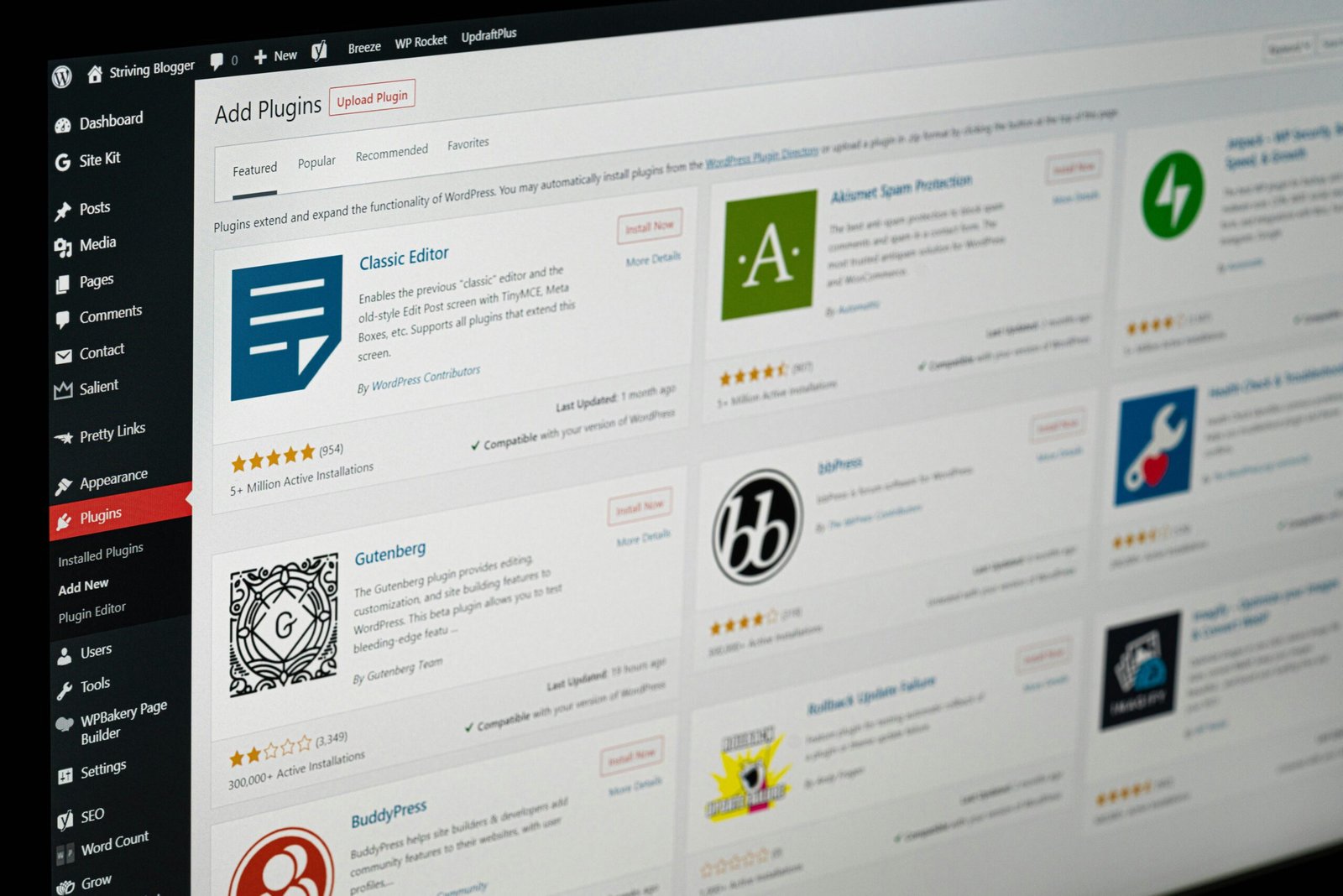Top 10 Essential WordPress Plugins Every Business Website Needs in 2025
Plugins power WordPress — but not all plugins are equal. This practical guide lists the ten plugins I recommend for any business website in 2025, explains why each one matters, how to configure it for performance and SEO, and offers trusted alternatives. The layout below uses cards so you can quickly pick what fits your project.

How to use this list
Start with performance, security, and SEO — these three areas form the backbone of a reliable website. After that, add tools for backups, forms, analytics, and specialized features (eCommerce, multilingual, marketplaces). For each plugin below I include: short description, key settings to apply, and alternatives.
Top 10 Plugins (Grid view)
1. WP Rocket (Caching & Performance)
WP Rocket is a comprehensive caching plugin that improves load times by combining page caching, preloading, and asset optimization (minify/concatenate). Its simple UI makes powerful performance tweaks accessible.
Key settings: Enable page cache, enable preloading, lazy-load images, optimize CSS delivery, delay JavaScript where safe.
Alternatives: LiteSpeed Cache (if host uses LiteSpeed), W3 Total Cache, or host-native caching.
2. Rank Math or Yoast SEO (SEO Suite)
Rank Math and Yoast are the go-to SEO plugins. They handle meta tags, XML sitemaps, breadcrumbs, schema, and offer content analysis. In 2025 Rank Math has gained traction for its modular approach and built-in schema; Yoast remains stable and familiar for teams.
Key settings: Configure sitemap settings, enable schema types you need (Article, FAQ, Product), connect to Google Search Console, and enable breadcrumbs if theme supports.
Alternatives: All in One SEO (AIOSEO), SEOPress.
3. WooCommerce (E-commerce)
WooCommerce is the leading eCommerce plugin for WordPress. It provides product management, cart, checkout, taxes, and extensible payment and shipping options. For businesses selling products (physical/digital), WooCommerce is essential.
Key settings: Configure payment gateways, set shipping zones, enable smart taxes where possible, and add performance-focused storefront themes.
Alternatives: Easy Digital Downloads (for digital-only), Shopify Buy Button for simple integrations.
4. Wordfence or Sucuri (Security)
Security is non-negotiable. Wordfence adds endpoint firewall and malware scanning, while Sucuri offers a cloud-based WAF and cleanup services. Both reduce risk and provide audit logs for suspicious activity.
Key settings: Enable firewall in learning mode, set up two-factor authentication (2FA) for admin users, schedule regular scans and enable alerting via email.
Alternatives: iThemes Security, Cloudflare WAF (useful as host-level protection).
5. Elementor (Page Builder) + Elementor Pro
Elementor remains the most popular visual builder for designers and developers. It allows fast creation of responsive pages and templates. Elementor Pro adds theme building, forms, and dynamic content features that reduce development time.
Key settings: Use global styles, build header/footer with Theme Builder, and export templates for reuse. Limit third-party widgets to avoid bloat.
Alternatives: Oxygen Builder (fast but developer-oriented), Beaver Builder, Brizy.
6. UpdraftPlus (Backups)
Backups are your insurance. UpdraftPlus automates backups to remote storage (Google Drive, S3, Dropbox) and simplifies restores. Schedule daily backups for dynamic sites and weekly for static brochure sites.
Key settings: Choose remote storage, keep at least 14 backups, include database and uploads, and test restore periodically.
Alternatives: BackupBuddy, Jetpack Backup (VaultPress), BlogVault.
7. WPForms or Fluent Forms (Forms & Lead Capture)
Forms are conversion points: contact forms, quotes, surveys, and checkout custom fields. WPForms and Fluent Forms provide drag-and-drop builders, anti-spam, and integrations with CRMs and email tools.
Key settings: Use reCAPTCHA or hCaptcha, enable email notifications, connect to CRM or Zapier for automation.
Alternatives: Gravity Forms (premium), Contact Form 7 (lightweight but less friendly).
8. Imagify / ShortPixel (Image Optimization)
Images often make or break page speed. Imagify and ShortPixel compress images, convert to WebP, and offer bulk optimization. Optimized images improve Core Web Vitals and reduce bandwidth.
Key settings: Set automatic compression on upload, enable WebP conversion and backup originals, and enable resizing for large uploads.
Alternatives: Smush, Optimole, or host-level image optimization (e.g., Cloudflare Image Resizing).
9. MonsterInsights / ExactMetrics (Analytics)
Accurate analytics are essential for measuring SEO and marketing. MonsterInsights and ExactMetrics make connecting Google Analytics 4 (GA4) to WordPress easy, plus they surface useful reports in the WP dashboard.
Key settings: Connect GA4, enable eCommerce tracking for WooCommerce, and set up conversion events (form submissions, purchases).
Alternatives: Manual GA4 integration, Matomo (self-hosted analytics).
10. Polylang / TranslatePress (Multilingual)
If you target multiple languages, Polylang and TranslatePress are excellent. Polylang integrates well with WooCommerce (Polylang for WooCommerce) while TranslatePress gives a visual translation experience. Proper multilingual setup helps SEO and user experience in international markets.
Key settings: Configure language switcher, translate important SEO fields (titles, meta), and set hreflang tags correctly.
Alternatives: WPML (premium), Weglot (SaaS translation).
Extra tools & plugins worth mentioning
Depending on your business, also consider: a WAF/CDN (Cloudflare), a posts-to-socials plugin, WooCommerce-specific extensions (subscriptions, bookings), and plugins for memberships (MemberPress) or LMS (LearnDash).
How to install and keep plugins lightweight
Too many plugins or poorly coded ones slow your site. Follow these rules:
- Limit active plugins to essentials; deactivate and remove unused plugins.
- Prefer modular plugins that let you enable only the features you need (e.g., Rank Math modules).
- Test performance with and without a plugin using tools like Query Monitor and PageSpeed Insights.
- Use a staging site to test plugin updates before applying them to production.
Recommended plugin stack for a new business website (example)
- WP Rocket (or host caching) — performance
- Rank Math — SEO
- Elementor + Elementor Pro — design
- UpdraftPlus — backups
- Wordfence or Cloudflare WAF — security
- Imagify/ShortPixel — images
- MonsterInsights — analytics
- WPForms — contact & lead forms
- WooCommerce — if selling products
- Polylang — multilingual (if needed)
Final checklist before going live
- Confirm caching and CDN are active and tested.
- Run Lighthouse / PageSpeed Insights and fix major issues.
- Verify sitemap & robots.txt; submit sitemap to Google Search Console.
- Test forms, payments, and backup restores.
- Enable two-factor authentication and set strong admin policies.